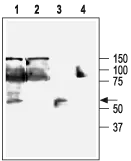
WB analysis of HEK-293-KCa3.1 (lanes 1, 3) and K562 (lanes 2, 4) cell lysates using GTX54786 KCNN4 antibody preincubated with or without immunogen peptide. Dilution : 1:200
KCNN4 antibody
GTX54786
ApplicationsImmunoFluorescence, ImmunoPrecipitation, Western Blot, ImmunoCytoChemistry, ImmunoHistoChemistry
Product group Antibodies
ReactivityHuman, Mouse, Rat
TargetKcnn4
Overview
- SupplierGeneTex
- Product NameKCNN4 antibody
- Delivery Days Customer7
- ApplicationsImmunoFluorescence, ImmunoPrecipitation, Western Blot, ImmunoCytoChemistry, ImmunoHistoChemistry
- CertificationResearch Use Only
- ClonalityPolyclonal
- Concentration0.8 mg/ml
- ConjugateUnconjugated
- Gene ID65206
- Target nameKcnn4
- Target descriptionpotassium calcium-activated channel subfamily N member 4
- Target synonymsIK1; intermediate conductance calcium-activated potassium channel protein 4; intermediate conductance K channel; intermediate-conductance Ca-activated K channel; KCa3.1; KCa4; potassium channel, calcium activated intermediate/small conductance subfamily N alpha, member 4; potassium intermediate/small conductance calcium-activated channel, subfamily N, member 4; rKCNN4c; rSK4; SK4; SKCa 4; SKCa4
- HostRabbit
- IsotypeIgG
- Scientific Descriptionion channel that exhibits intermediate conductance [RGD, Feb 2006]
- ReactivityHuman, Mouse, Rat
- Storage Instruction-20°C or -80°C,2°C to 8°C
- UNSPSC12352203
References
- In vitro generation of functional murine heart organoids via FGF4 and extracellular matrix. Lee J et al., 2020 Sep 3, Nat CommunRead more
